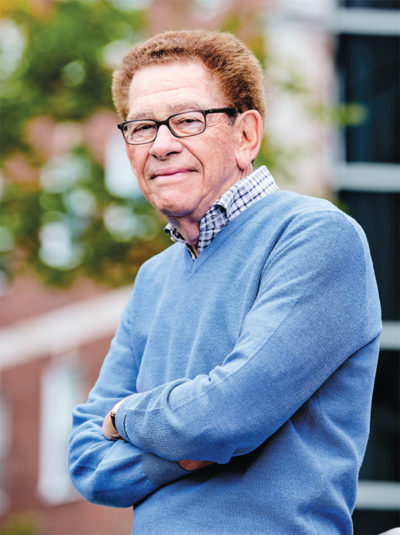
Senior Lecturer Ed Marram
Photo: Michael Quiet
Ed Marram isn’t just interested in helping students become successful entrepreneurs. He wants them to make a difference in the world.
After a successful scientific career that led him to found and grow his own business, Marram, a senior lecturer in entrepreneurship, made time to study under Professors Neal Churchill and Bill Bygrave at Babson until he felt ready to teach. He has been a faculty member in the Entrepreneurial program for more than 30 years, starting as an adjunct lecturer, then joining the full-time faculty after he sold his business in 2005.
Marram teaches Managing Growing Businesses, a graduate-level course designed to provide insight into the challenges and opportunities of growing an entrepreneurial company, and a number of executive education courses. He has taught students from all around the world, both at Babson and in their home countries. Some of those relationships have become long-term commitments. For example, Ulster University in Northern Ireland, started coming to Babson about 12 years ago to learn about entrepreneurship. Last year, Ulster awarded Marram with an honorary doctorate.
“I’m surprised by how much knowledge and interest my students have,” Marram says. “All of them want to be entrepreneurs—and all want to know how to better run a business.” But his students’ focus isn’t just on the bottom line, he notes. Many are creating socially responsible businesses. “It’s not just about making money,” he says. “It’s about doing good for people and the environment.”
For example, one of Marram’s students provides microloans to poor women in Mexico. “A small loan doesn’t change their socioeconomic status, but it does make a huge difference in their individual lives,” Marram says.
Marram brings a wealth of entrepreneurial knowledge to Babson. He owned Geo-Centers Inc., a high-technology, professional services firm, for more than 35 years, growing the business to a staff of 1,400 people and $200 million in revenue. The firm was recognized twice by Inc. magazine as one of the fastest-growing, privately held companies in the United States. That background, he notes, brings “broad, real-life experience—and real-life problems—to the classroom.”
Beyond his work at Babson, Marram has served on the boards of several privately held companies and at institutions of higher education. He is a member of the National Association of Corporate Directors, and he previously served on the Health and Educational Financial Authority of Massachusetts.
Marram speaks with pride about the learning experience at Babson. “The unique thing about (the College) is that it has practitioners like me teaching entrepreneurship,” he says. “What better enrichment can you have than people who have actually experienced and survived the issues companies face?” – Amy Davis
]]>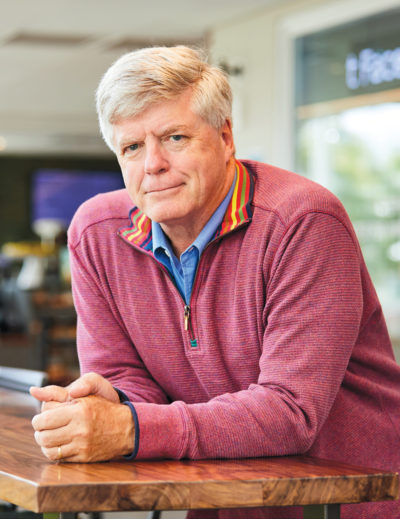
“There is not cause for mass panic. The fact is that nobody really knows the percentage of jobs that will be automated over what time frame.” – Tom Davenport, the President’s Distinguished Professor of Information Technology and Management
Photo: Pat Piasecki
Let’s clear up one thing first: Contrary to what you may have seen in the movies, killer robots won’t be running amok anytime soon.
“There is not much evidence that killer robots are coming for us in the foreseeable future,” says Tom Davenport, the President’s Distinguished Professor of Information Technology and Management.
That’s not to say that the never-ending march of technology, particularly in regard to artificial intelligence (AI) and machine learning, doesn’t pose legitimate concerns about bias, misinformation, and a host of other possible issues. As AI grows more sophisticated, it will become a greater part of our workplaces and our lives.
For now, at least, the changes brought by AI are incremental, says Davenport, who has written two books on the technology, including The AI Advantage: How to Put the Artificial Intelligence Revolution to Work. Davenport tends to believe in Amara’s Law, which says humanity typically overestimates the effect of a new technology in the short run and underestimates the effect in the long run. “So far, the changes with AI are evolutionary rather than revolutionary,” he says. “It’s not something to be scared of.” Instead of fear, what AI represents is opportunity. For workers, AI potentially offers a way to do their jobs better. Furthermore, for entrepreneurs and business leaders, the new technology means new ventures, new ways of thinking, and new possibilities. Davenport encourages all businesses to look into AI. “You don’t want to be left behind,” he says.
AI at Work
Perhaps the biggest concern about AI is the potential loss of jobs from the technology. Just how many jobs could be lost, though, remains unknown. Headline-grabbing reports predicting massive unemployment appear to be overblown, Davenport says. “There is not cause for mass panic. The fact is that nobody really knows the percentage of jobs that will be automated over what time frame.”
Of course, some jobs are at more risk than others. Jobs that require empathy, creativity, or flexibility are harder to replicate than those with repetitive, predictable tasks. Jobs that require direct human contact (nursing, for example) also are safer than those that are predominantly performed digitally (radiology). “You want to make sure you are doing things that aren’t easily replaced by a machine,” Davenport says. “My son is a TV comedy writer. Machines are very bad at comedy writing.”
In many workplaces, however, employees may find their jobs augmented, rather than automated, by AI. Instead of replacing humans, says Davenport, machines could complement them and serve as a colleague of sorts, performing tedious tasks or helping workers make complex decisions.
One company bringing AI to the workplace is Gravyty, a provider of AI-enabled fundraising software. Based in Newton, Massachusetts, Gravyty works with colleges, hospitals, and other nonprofit organizations that are tackling a range of serious societal challenges, such as treating Alzheimer’s disease, curing cancer, and eradicating poverty.
“Our mission is helping their mission,” says Gravyty’s chief technology officer, Rich Palmer MBA’16, who co-founded the company with CEO Adam Martel, a Babson MBA candidate who once worked in the College’s development office. “We take inspiration from all of our clients. They are doing all kinds of beautiful things for the world.”
Gravyty offers clients a variety of AI-powered capabilities. Its software, for instance, can identify and prioritize potential donors in each client’s network.
One organization was able to land a $50 million gift after Gravyty software singled out a new potential donor. “He was in a pool of people they knew about, but no one had previously taken the time to talk to him,” Palmer says.
Gravyty’s software can draft emails to send to donors, and when fundraisers make edits to those emails, the AI is taking note. “The AI system is constantly learning how you talk,” Palmer says. “The more you use the system, the better it gets. The next time an email comes up, it’s a little better.”
Gravyty also can help clients organize their fundraising trips, figure out which potential donors to meet for coffee or take to dinner, and even suggest restaurants where they should dine. That scheduling can save fundraising staff a lot of time.
“Fundraisers already do a lot of this, but it may take them all day to set up a meeting,” Palmer says. In fact, Gravyty case studies have shown that its products enable one fundraiser to do the work of 10. Have a staff of 10, the company claims, and they can now do the work of 100.
That’s welcome news for an industry that is always in need of talent. “There is a lot of turnover,” Palmer says. “Every nonprofit has open jobs now.”
AI in Our Lives
Outside the workplace, AI may influence our lives in myriad other ways in the future, says Davenport. To name just a few possibilities, AI may help analyze the human genome, assist doctors in predicting who might have a heart attack, or increase the mobility of seniors through autonomous vehicles.
Waycare, based in Los Angeles and Tel Aviv, Israel, is using AI to create safer, less-clogged roadways. Typically, says co-founder and CEO Noam Maital ’12, accidents and congestion are responded to after the fact. Two cars collide, and that’s when police are called to the scene. Traffic backs up, and that’s when motorists are notified of the delay by phones and news reports. “A big problem is that we are reactive by nature,” Maital says.
Waycare seeks to change that. Utilized by municipalities and departments of transportation, Waycare’s AI platform analyzes all kinds of data—from accident reports to traffic cameras to weather forecasts to navigation apps on driver smartphones—to predict congestion and accidents before they happen. “The data is overwhelming, but it can be turned into actionable insights in real time,” Maital says.
That’s what happened in Las Vegas. Waycare was used to cut vehicle crashes by 17 percent on a stretch of city interstate last year. The company identified when and where crashes were likely to happen, and then government agencies took steps to reduce motorists’ speed. Digital highway signs prompted motorists to slow down, and police cars with flashing lights were stationed in high-risk areas.
For cities dealing with traffic problems, Maital thinks technology offers a better and more cost-effective solution than trying to expand roadways and overhaul infrastructure. “They can’t pave themselves out of the problem fast enough,” he says. “They have to be smarter.”
Waycare and Gravyty illustrate the capability that AI has to improve our day-to-day lives, both in the office and out. They also show AI’s business potential, which is far-reaching. “In my mind, no industry is immune to the transformational potential of AI,” says Gravyty’s Palmer.
Indeed, the technology is moving ever forward. That relentless progress is not something to fear, but it’s also not something to ignore. “There are serious first-mover advantages to adopting AI,” Palmer says. “Now is the time for entrepreneurs of all kinds to put AI to work or they’ll fall behind, and it may be hard to catch up.”
]]>The professor known as ‘Dr. Failure’ leads a bustling, global life
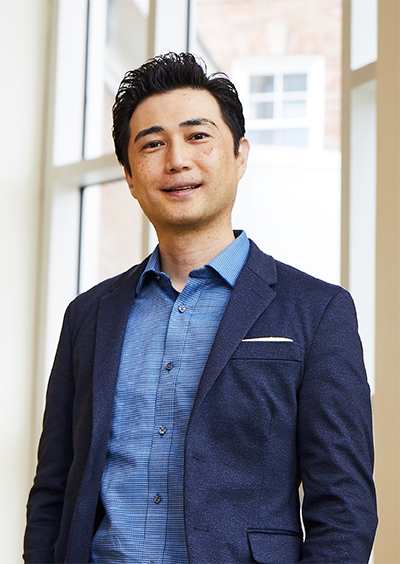
Yasuhiro Yamakawa
Photo: Pat Piasecki
To see Yasuhiro Yamakawa’s online calendar is a bit astonishing. Block after block of time is filled. When others see it, they ask when he has time to eat lunch or dinner.
“We always teach our students to be in action, to learn while doing. I’m just practicing what I’m teaching,” says the associate professor of entrepreneurship, who’s affectionately known as “Dr. Failure” for teaching students to welcome the setbacks that inevitably come in entrepreneurship and business.
Yamakawa has much to keep himself busy. Beyond his work at Babson, he is involved in 16 U.S. and international businesses as an investor, advisor, or board member. Based in Boston, he travels regularly, and he even makes time for a lunchtime ice hockey game three days a week. “I like to be in motion all the time,” he says.
One place Yamakawa frequents is Japan. He was born there, though he moved frequently as a child and continued the wayfaring life as an adult. In all, he has lived in eight countries. “Whenever there was an opportunity for me to jump on something, I moved,” he says.
Once he finally landed at Babson, however, he stopped. He has been at the College for 10 years. He finds it inspiring, and he enjoys interacting with his action-oriented students. “This is the longest I’ve ever stayed in one place,” he says. “I have a good reason. I just love Babson.”
In Japan, Yamakawa leads undergraduate and MBA elective abroad courses. He also is the executive director of Venture Café Tokyo, which hosts a weekly gathering of entrepreneurs, intrapreneurs, investors, educators, and students.
Yamakawa speaks regularly to colleges and companies in Japan. Failure is a frequent topic, which can make businesspeople uncomfortable. “Everyone goes silent,” he says. “Everyone starts looking down.”
Many in Japan see failure as source of embarrassment. So Yamakawa’s message, that failure should be embraced for the many important insights it can offer, is a startling one to Japanese audiences. “It’s all about failing, learning, pivoting, and finding the most successful pathway,” he says.
Yamakawa knows that changing an entire country’s culture is not easy, but when he finishes his talks on failure in Japan, he often receives a standing ovation. – John Crawford
When the Lab Meets the Classroom
David Blodgett integrates his diabetes research into his classes in multiple ways
David Blodgett doesn’t remember anything from his Type 1 diabetes diagnosis just before his third birthday, but that milestone has shaped some of his life’s work in indelible ways.
Blodgett, an assistant professor of biology who joined Babson’s faculty in 2012, also is a diabetes researcher at the University of Massachusetts Medical School, focusing on beta cell gene expression patterns. He and his colleagues examine differences and changes in hormone-producing human pancreatic islet cells, which come from donors who had Type 1 or Type 2 diabetes, were prediabetic, or didn’t have diabetes. Observing those characteristics may be the key to understanding how the diseases develop, and how to treat them.
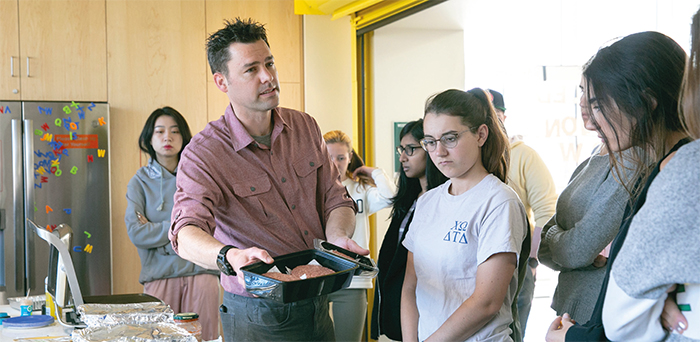
David Blodgett
Photo: Paige Brown
His academic sweet spot is at the intersection of teaching and research, where he can include some of the processes and findings of his research in classes on human biotechnology and sustainable food systems. “For human biotechnology,” he says, “if we’re talking about reprogramming stem cells to become beta cells, that ties back to genetic engineering and personalized medicine.”
Case Studies in Sustainable Food Systems examines the pathways food takes from farm to table, and includes topics such as food security, technology, GMOs, conventional versus organic farming, food waste, and agriculture and climate change.
In this class, Blodgett highlights his thought processes and the systematic ways of doing research to analyze a situation. “For example, plants that are grown in soil—how is that soil treated, and what are the consequences of those treatments? What conclusions can you reach, which ones can’t you reach, and what additional data do you need? These are the same things I ask myself in my research.”
Blodgett likes having two worlds to work from. “I’m lucky enough to have those two perspectives,” he says, “and I think that makes me a better teacher and a better researcher.” – Jeannine Stein
]]>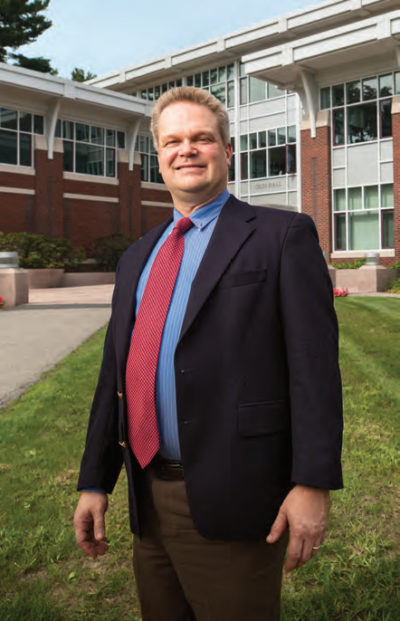
Photo: Tom Kates
Keith Rollag, Murata Dean of the F.W. Olin Graduate School of Business
For seven years, he worked at Procter & Gamble. After graduating with a degree in chemical engineering, Rollag took a job in product development. “I spent several years designing Pampers baby diapers. If you had told me that as a college student, I would have said there’s no way. But actually it was a fascinating product and a competitive industry.” After a few years, Rollag was looking for a more entrepreneurial endeavor within the company, so he transferred to its R&D division in Japan. “I got my passport, started taking some Japanese lessons, and six months later took my first trip out of the country to move to Japan. I spent almost five years there as a product development manager and then as a technical training manager.”
His Ph.D. is in industrial engineering with a focus on leadership. “I was interested in leadership, because I found that in technology development, the technology is often the easy part. It was leading, influencing others, and making changes that was the hard part. So I was at Stanford for about six years, and I focused specifically on newcomers and how you bring them into organizations.”
In the next few years, he sees big changes in graduate education. “It’s changed a lot already in terms of what people are looking for in their education, but it’s going to change so much more. The newer generation of prospective students wants something that’s—in the words of David Abdow, the dean of Executive and Enterprise Education— just in time, just enough, and just for me.” Babson will remain what Rollag calls “high touch,” meaning it will continue to value strong interactions among faculty, staff, and students. But the College also plans to rethink the structure of its MBA, with a smaller core and more electives, and it will expand offerings of smaller, less expensive credentials such as certificates. “This will make it easier for us to adjust our portfolio and learning experiences to match market demands. We’re also giving students the flexibility to tailor their learning experience to their goals and life constraints.”
Education is not just about information anymore, says Rollag. “A lot of what people went to business school for before is now obtainable through two clicks on Google. There are countless articles and videos on leadership and business and entrepreneurship. I was at an HR conference, and a speaker said that by 2030, you’d better be out of the credential-selling business, or you won’t be here. People come to Babson to solve a professional development challenge, whether they want to be promoted or change careers or start a business. And we help them solve the challenges they are dealing with today. We don’t just provide information. We provide professional and business development solutions to individuals and organizations.”—Donna Coco
]]>
Photo: Bruce T. Martin
The new Weissman Foundry, which gives Babson, Olin, and Wellesley college students a space to build, collaborate, and explore ideas, is now open.
The 10,000-square-foot studio offers a range of workspaces for making anything from furniture to food, machines to movies. Access to hand tools, digital fabrication equipment, robotics, virtual- and augmented-reality technology, and more will be provided to students. Located on Map Hill Drive and named for Babson trustee Robert Weissman ’64, H’94, P’87, ’90, and his wife, Jan Weissman, P’87, ’90, the Foundry is open 24 hours a day, seven days a week, making it available to students to work—and get feedback from others—whenever inspiration strikes.
“The goal is to create a place where creativity and inspiration can not only happen, but be taught and learned and implemented into ideas for all three schools,” explains Janos Stone, the new Foundry’s manager of innovation and design spaces.
Stone is no stranger to hands-on creativity. A graduate of the Rhode Island School of Design, Stone is a designer and sculptor whose work has been shown in New York City and internationally. He has taught design at the university level and founded or co-founded three companies, all built around “helping people use their inherent creativity to create a better environment or products for themselves,” he says. He is currently launching a fourth company, which makes kids’ minimalist playhouses constructed of corrugated plastic using “thick origami” techniques. Stone plans to use the same principles to create privacy screens in crowded refugee camps.
Soon after he was hired in the summer, Stone set to work hiring an equal number of students from Babson, Olin, and Wellesley to staff the foundry. He calls these employees “scouts,” with the idea that they support Foundry visitors in their creative processes. The goal is to ensure that the Foundry has a “nurturing, exploratory environment” that frees people to think in fresh ways.
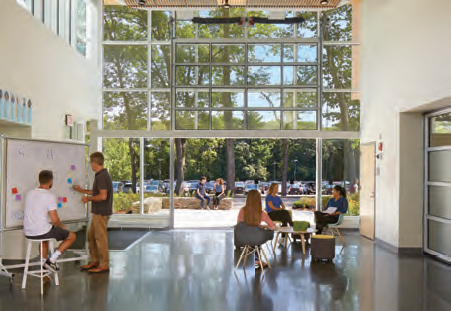
Photo: Bruce T. Martin
Stone and the scouts gather at 5:30 on Monday evenings for regular meetings called “campfires.” “Those meetings are open to anybody, including faculty and students from any of the three schools,” Stone explains. The campfires give all a chance to discuss current and future projects or propose new programs and events.
Stone is encouraging Foundry users to think like artists and push boundaries. “That’s going to make better entrepreneurs,” Stone says. “The end result is people who are more creative in their thinking, who can develop better business models and better solutions, and who can take what they’re working on and make it more functional and valuable.”—Erin O’Donnell is a freelance writer in Milwaukee.
]]>Blockchain technology, as experts will explain, is a digital, shared, distributed ledger—a means for recording and tracking various kinds of transactions, not just financial ones—that offers security due to its structure. The information in a blockchain is organized in “blocks” that are interconnected using complex math, which results in it being extremely difficult for someone to change the recorded data. No one party controls the information, and certain transactions can be programmed to trigger automatically, removing the need for intermediaries and reducing or eliminating paperwork. Perhaps the most publicized application of blockchain technology is the buying and selling of cryptocurrency. But the technology can be used for secure tracking of myriad data, including supply chains, health and insurance records, and much, much more.
After learning about blockchain, Rodrigues, who had been thinking about becoming an angel investor, began discussing its opportunities with two former co-workers from his days at the fintech venture. In 2016, the colleagues decided to found Adjoint, which offers smart contract language, distributed ledger, and software development kits that can be used by enterprises to create applications built on blockchain. Rodrigues isn’t the only Babson graduate staking a claim in blockchain. Numerous other entrepreneurial thinkers are moving on opportunities related to this up-and-coming technology. Babson professors also are tracking blockchain, and Steven Gordon, professor of information systems, began offering courses addressing the technology last spring.
But for many, blockchain technology is still something of a mystery—and that needs to change, say those already involved. The time is now for businesses to learn about blockchain’s potential and applications, and how it may relate to their operations. At the same time, they advise common sense. “I have to remember what I learned at Babson, and I remind myself every day—you have to solve problems,” says Rodrigues. “You don’t use blockchain because it’s cool. You need to solve a problem and make sure it’s meaningful.”
The Benefits
John Hargrave, MBA’04, is CEO of Media Shower, a blockchain consulting and strategy firm and publisher of the online Bitcoin Market Journal. Hargrave’s interest in blockchain began in 2013 when he invested in the cryptocurrency bitcoin. “At the time, I thought it was one of the weirdest, most unusual things I’ve done,” he says. “My wife said, ‘What are you doing?’ But I had read about it and got really interested and watched the price go from literally nothing to a few cents to a few dollars to about $125 when I bought it. It’s about $6,000 now. It fluctuates, but after you’ve done it for a few years, you realize it’s here to stay.”
Hargrave fundamentally believes in blockchain, the technology that underlies the bitcoin cryptocurrency. As a blockchain consultant, he advises companies to learn about the technology, even if they aren’t sure whether it will impact their business. “This applies to any industry,” says Hargrave, who also is writing Blockchain for Everyone, which will be published next year by Simon & Schuster. “You need an expert who can be the evangelist in your organization—someone who can be prototyping new technologies and be the entrepreneurial test bed. If you wait to educate the organization until you know what blockchain is all about, by the time it all plays out, it’s too late.”
Paul Quigley, MBA’02, is managing director of Cornerstone Healthcare Consulting, a national health-care technology consultancy. He also is CEO of its affiliate company, Bloclab Enterprises, which focuses on the strategic use of blockchain across the health-care and life sciences industries. Blockchain is a cryptographically secure way to transmit and store data in a transparent and immutable way. As such, it has the potential to be used by many industries. When explaining the technology, Quigley turns to the metaphor of a railroad. “You have a railbed, and the rails and the ties that make the railbed stay in place and conform to specific standards,” he says. “If you have a train and you want it to run on that railbed, it has to be compliant—a certain width, for example—or it won’t run on the tracks. Blockchain is that compliant railbed, and on that you can create highly specialized applications—trains—that run on the railbed.” An example of a specialized train, he notes, would be the cryptocurrency bitcoin.
One of the main benefits of blockchain is removing certain intermediaries from transactions, says professor Gordon. “In business, we teach that disintermediation is usually good,” he says. “Typically, intermediaries slow things down, they add cost, and they have their own agendas, which may be different from yours.”
Blockchain brings trust to operations, adds Quigley. The technology makes it extremely difficult to change information once it’s entered in the chain, and all transactions are recorded and updates can be viewed by all participants. These factors alone build trust, he notes, but, additionally, by sharing secure data across a distributed computer network instead of a centralized one, blockchain reduces the risk of data breaches. “Frequent data breaches have eroded consumer trust with central organizations,” Quigley says. “People don’t trust these entities to protect their information. There are going to be a lot of experiments with blockchain, and some will fail. But we’ll learn something every single time and will continue to advance the technology.”
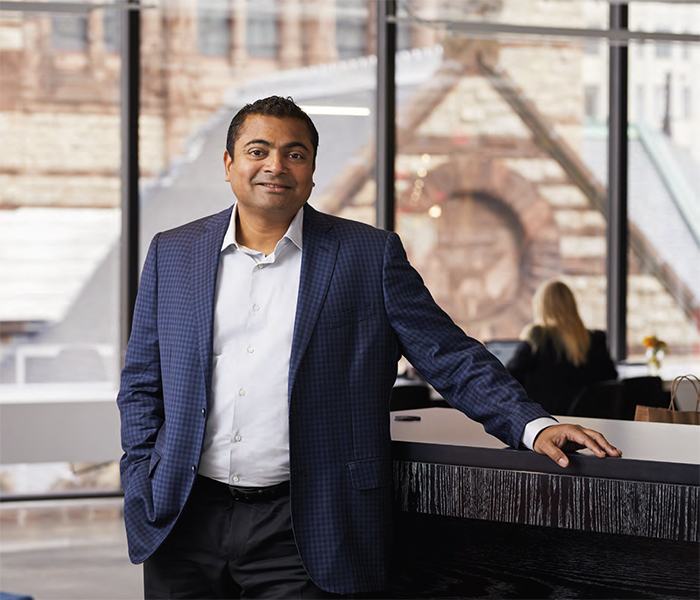
Photo: Pat Piasecki
Havell Rodrigues, MBA’03, CEO and co-founder of Adjoint
Sooner Rather than Later
Certain industries will potentially be affected by blockchain before others, notes Hargrave. He cites financial services, even beyond cryptocurrencies, as an example. Take, for instance, the difficulty of dealing with banks for tasks like sending and receiving money, especially overseas. That’s the kind of challenge that’s driving adoption, says Hargrave, because blockchain removes banks from the process.
Gordon adds that banks themselves are exploring the technology. “When banks settle transactions among themselves, they have to go through clearing agencies,” he says, “which slows things down by three or four days. And there’s the cost of maintaining that agency.” Blockchain can automate and expedite these transactions.
Finance is a target market for Adjoint, notes Rodrigues. For example, one of its customers is a Fortune 500 company with subsidiaries operating in more than 70 countries, so it deals with multiple currencies. “One problem was visibility as to where cash is, but also having an easy and secure way to move cash intracompany,” says Rodrigues. “They came to us looking for a solution, and we built it out for them. Now we’re deploying that product, Smart Treasury, to other companies. Large companies looking to use blockchain to improve margins by reducing costs in existing operations—such as by automating processes, instead of manually recording data for transactions and spending time reconciling—would be interested in our product.”
Lilya Tessler ’05, MS’06, recently joined the law firm Sidley Austin as a partner and New York head of fintech and blockchain in its Securities & Derivatives Enforcement and Regulatory group. She has been involved with blockchain technology for several years. “I was working to build a fintech clientele, and a big blockchain token exchange company was one of my clients. It asked us to apply securities laws to blockchain token sales,” she says. “Since then, cryptocurrencies have proliferated, and the industry has become more regulated. In the U.S., the issuance of tokens, which use blockchain technology, may be viewed as securities issuances.”
Tessler works with financial services firms, blockchain technology companies, firms offering cryptocurrencies, and digital asset trading platforms. She helps her clients with a range of services, from understanding the regulatory implementation of their technology to the sales and distribution of tokens on their networks. “I’ve advised on token issuances, which are capital markets and fundraising activities engaged by blockchain companies. I advise clients from a securities law perspective,” she says.
Tessler also educates clients about policy and guides them through regulations. “There have been a lot of headlines that blockchain is a fad, but I think it’s becoming more mainstream. It’s not going away,” Tessler says. “For financial services that are trading in blockchain digital assets, they need to understand the technology and cryptocurrencies. But even if they’re not trading in them, people should be educated about them, including the regulatory requirements. Know what those are and how they apply to your business.”
Own Your Identity
Another industry currently examining how blockchain may improve operations is health care. In addition to streamlining payments, the technology is being considered for medical records, says Quigley of Bloclab Enterprises. He notes it could simplify and secure the tracking of patient information, creating one patient-controlled data set that can be accessed by many—doctors, hospitals, dentists, for example—with the appropriate permission. “It’s consent-based data management,” Quigley says. “Consider when you enter a practice, there are all these arduous forms that you repeatedly fill out. They include family history, past medical history, medications that you take, and allergies. If you put that information into a ledger and secure it with a cryptographic hash placed on the blockchain, it’s locked down. No one can change it without the appropriate permission.”
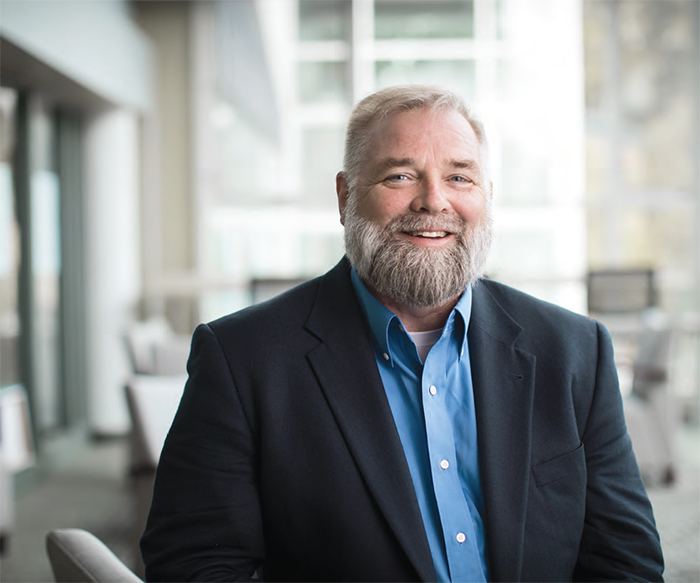
Photo: Tom Kates
Paul Quigley, MBA’02, managing director of Cornerstone Healthcare Consulting and CEO of its affiliate company, Bloclab Enterprises
While he’s a strong proponent of blockchain technology, Quigley isn’t completely on board with using it for all health records. Some technical and practical problems exist, such as certain information—for example, a CT scan—being too big to store efficiently. “A CT scan can be 100 megabytes in size. It’s totally impractical to store that on the blockchain,” Quigley says. “But there’s data in the image that can be compressed and put on the blockchain—things like name, age, date of birth, allergies, medical history. There’s a compelling argument for blockchain in this case, and some health systems are trying it. But it’s important when developing the business case to ask what needs to be ‘on chain.’”
Identity management is a key focus for Quigley. He consults about blockchain with companies in such industries as life sciences, pharmaceuticals, and biotechnology, all of which typically conduct patient-based research. “The idea is that the consumer owns their information, like their genome, and can rent it to a researcher,” he says. “Right now, identity management is very fragmented and not only in health care. There are a lot of companies mining your information. Credit cards, stores with their loyalty programs, all the programs you use on your cell phone and on the internet—they’re all creating profiles for behavioral economics. Blockchain will give the consumer a mechanism to control how their information is used and not used.”
Hargrave also believes strongly in the concept of identity management. “Wouldn’t it be great if you could keep all of your medical records on the blockchain and only share those pieces of information with your permission?” he says. “I do a whole rap on Equifax, the credit-reporting agency that took all our information without our knowledge and then lost it to hackers. We should be in charge of our personal data. No company should be able to take and harvest our data without our consent. It’s a fundamental human right.”
Improved Tracking
The use of blockchain technology in supply-chain management also is being developed. “I think everybody sees the value of blockchain in this application because of the disintermediation and transparency and ability to track products along the way,” says Gordon.
Quigley agrees and thinks blockchain is beginning to play a critical role in supply-chain management, helping to track and confirm orders as well as manage such details as product integrity, availability, and pricing. “If you use a distributor, you don’t have transparency, or what is called line of sight. If I’m a company with a complex supply chain, I don’t like that. I want a clear line of sight to my suppliers, and I want to know that the information is accurate,” Quigley says. “It goes back to data being immutable, or unchangeable, and transparent, which results in trust.”
Perhaps one of the most publicized applications is in the food industry, with Walmart and reportedly 10 other large companies working together to create a blockchain that tracks their food supply chains. IBM is providing the technology and calls the initiative the IBM Food Trust. An important goal—in addition to improved transparency, standards, and record keeping—is better handling of food recalls. Because blockchain would capture data along all points of the supply chain, it would allow for quick identification and tracking of problems. Faster recalls of unsafe foods should benefit not only consumers but companies, too, because they can avoid the often huge losses associated with these recalls.
“What happens now is someone says the romaine lettuce is tainted, and suddenly everyone across all of the Western part of the United States is throwing out romaine lettuce,” says Rachel Greenberger, MBA’11, adjunct lecturer and director of Food Sol at Babson. “Blockchain lets a company immediately find out which farm or pool of romaine lettuce in a specific area is contaminated and recall that product, leaving everybody else alone.”
Greenberger believes the potential for blockchain to change the way the food industry functions—improving methods for proof of provenance, increasing safety and efficiency, reducing waste—is enormous. Although she says it’s still too early to know exactly how blockchain will play out, Greenberger thinks it will be adopted quickly if there is money to be made. “Right now, there are still a lot of fax machines and paper and human error. We have one of the safest food supply chains in the world, and yet there are a lot of gaps in its management,” she says. “If a giant company, like Walmart, for example, adopts blockchain, then because of its size and command over the industry, many smaller players will have to get on the Walmart chain as well.”
Entrepreneurs in the food industry should be learning about blockchain and watching its evolution, she continues. “If this gets adopted by major players in the food industry who call the shots on how everything else comes down, then if you want to sell to them, you will have to be thinking about blockchain as part of the way that you move and share data,” Greenberger says. “It’s early. There are not enough cases in the food industry yet. But I tell entrepreneurs to keep on this. It could change everything. You need to know it.”
Points to Consider
Financial services, health care, and food are just a few of the industries that soon may be affected by blockchain, as are insurance and reinsurance, media and entertainment, and real estate. So how does a business determine whether blockchain might potentially impact its operations? Quigley suggests asking the following questions: Is your business part of a data intensive ecosystem? Does it operate in a low-trust environment? Does it require multiple partners or trading partners to get goods and services to market? If the answers are yes, says Quigley, then those businesses should explore the benefits that blockchain could provide and, potentially, start experimenting with the technology.
Hargrave says companies that think blockchain may be in their future should consider hiring developer talent, so they can start experimenting with the technology. Hargrave also suggests networking with others in the blockchain space and attending one of the blockchain events he frequently hosts at Babson’s campus in Boston. “Find a consortium or industry group,” says Hargrave. “Go to conferences and industry events and talk with people.”
Companies also need to decide if they want to use a public or permissioned blockchain. As its name suggests, a public blockchain allows anybody to participate, says Gordon. He cites the example of LBRY, a digital library of artistic content—videos, music, speeches, and more—which was developed using the same blockchain technology as bitcoin. “Artists can sell directly to users. LBRY doesn’t take a cut,” he says. “One of the advantages from their perspective is it can’t be censored. People can put whatever they want on there. LBRY doesn’t control what goes on.”
In permissioned, or private, blockchain, access to the blockchain is controlled by one or more parties, notes Gordon. “You don’t allow people to participate unless you know who they are,” he says. “There are advantages to that for businesses that deal with regulations and want to preserve those conditions.”
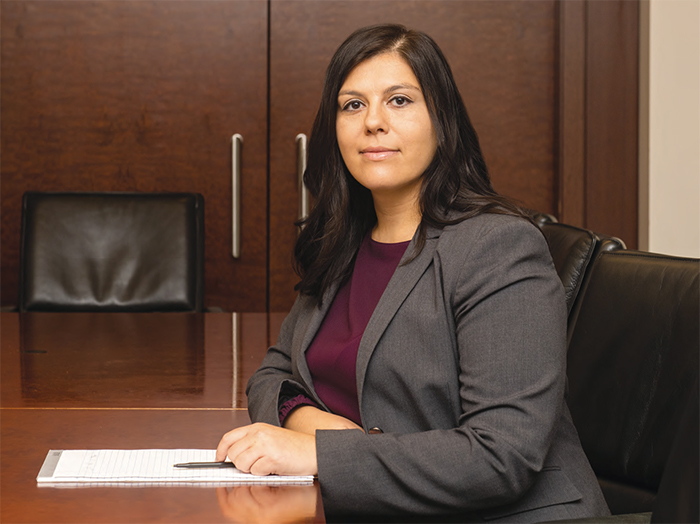
Photo: Chona Kasinger
Lilya Tessler ’05, MS’06, partner and New York head of fintech and blockchain in the Securities & Derivatives Enforcement and Regulatory group at law firm Sidley Austin
Rodrigues of Adjoint says his clients prefer this approach, adding that permissioned blockchains still provide a single source of truth of transactions, distributed recording, and strong immutability. “But it’s private,” he says. He sees consortiums, such as the IBM Food Trust, and large companies with various divisions or subsidiaries as potential early adopters of permissioned blockchain.
The Road Ahead
Much still needs to be developed before blockchain will become mainstream, note participants. The infrastructure needed to make the bitcoin blockchain work requires a tremendous amount of energy, says Gordon, as do those of other blockchains that work on the same principles. Interoperability across different blockchains needs to be developed as well, as does better scalability, or the number of transactions that can be processed per second, especially for public blockchains. More tools for developing applications also are needed. All of this takes time, says Gordon. “The technology is still in its infancy. Technical things need to play out so we can see if they work right,” he says. “It takes a while for any innovation to penetrate.”
Gordon sees blockchain becoming more mainstream in five years. Rodrigues thinks it may happen a little sooner, perhaps in less than three to five years. “I’m an optimist,” he says, but he also has seen market research predicting enormous growth for blockchain. “Companies definitely should start looking at it. If you’re a large enterprise, you will soon see your business model being disrupted. You will be left behind by not taking advantage of this technology.”
From an entrepreneurial perspective, Gordon believes the time is now to become involved. “Our students are very interested. Blockchain is part of the world, so it is something they need to know about,” he says. “I think the next unicorn, or maybe the next few unicorns, are going to come from blockchain applications.”
Tessler of Sidley Austin also sees great opportunities for entrepreneurs interested in blockchain. “There are a lot of emerging companies developing blockchain solutions, and there is not enough talent in this space,” she says. “These companies are raising substantial funds from venture capital and through token sales. I’m seeing companies building out teams with a big base of funds to support them.”
Hargrave agrees, saying the entrepreneurial opportunities are “limitless.” “I am constantly having people come up to me and saying, ‘I have an idea’—and I think, that’s a perfect idea. For example, someone suggested to me an app to track all the plutonium in the world so that we could see ownership of it, and I thought, that’s the perfect application for blockchain,” says Hargrave. “I hear them every day.”
]]>A few years ago, Abby Speicher Carroll, MBA’15, was set to present at a business plan competition. Her business, DARTdrones, was a flight school for people learning to pilot drones, those increasingly common flying machines buzzing and soaring about the skies.
At the time of the competition, the company wasn’t much more than a concept and neither Carroll nor her team actually knew how to operate a drone. Regardless, they decided on a whim to order one so they could demonstrate how it flies as part of their presentation.
When the new drone arrived, however, it came with no instructions, or at least, no directions in English. The hour Carroll spent practicing how to fly it proved, in hindsight, to be comically inadequate. During the competition, as the drone lifted into the air, the judges watched eagerly. “They thought I had everything under control,” Carroll says.
That wasn’t exactly true. “It went the opposite way from what I expected,” she says. “It was flying right above the judges. They were scrambling to get away.” Her father, Chris Speicher, who also is a co-founder, tried to grab the drone out of the air. Eventually, it crash landed in front of Carroll, bringing the demonstration to an unceremonious end. “Everybody thought it was hilarious, but I literally still have nightmares about it,” says Carroll.
The entrepreneurial journey is often not a smooth ride, and a hard landing or two is to be expected. Building DARTdrones since that shaky flight, Carroll has experienced uncertainty, stress, and many long hours. But she understands that the startup process is an untidy, exhilarating mess, and she has come to thrive on it. “I love chaos. I love flux. If it’s not in flux, I make it in flux,” she says. “With any company, there are endless problems. This is how business is. You have to deal with it.”
Not that she has experienced only problems. There also have been triumphs, including an appearance on the TV show Shark Tank, and she relishes that DARTdrones is a family affair, with both her father and husband on board. Today, the venture offers training in 40 cities across the U.S., with instructors who have military and commercial flying expertise, and organizations are turning to DARTdrones to understand a technology that’s poised to become a ubiquitous part of our future.
On the Hunt
For years, drones were the purview of the military. Any civilian use seemed limited to hobbyists fooling around with drones in a park. That’s changing. Earlier this year, the Federal Aviation Administration announced that more than 1 million drones had been registered with the agency. Drones have been used to watch whales and document volcanic eruptions, to survey flood damage and find survivors after natural disasters, to check insurance claims and inspect power lines. UPS is testing delivery trucks outfitted with drones, and images taken by drones are common in movies and news broadcasts.
“There are endless possibilities,” says Colin Romberger, chief pilot and operations consultant at DARTdrones. “At this point, it is a wide-open canvas.” DARTdrones is well-suited to help companies figure out these many capabilities, but keeping up with the evolving industry and its steady changes in technology and regulation isn’t easy. Mike McCann, enterprise account manager at DARTdrones, gives credit to the forward-thinking Carroll. “She has got to be a year ahead, knowing what’s coming,” McCann says. “She is really on top of things. Abby amazes me.”
Carroll developed the concept for DARTdrones during her first year at Babson. She had come to the College determined to pursue an entrepreneurial venture—she just needed to figure out what that would be. It was a busy time. She had to contend with schoolwork, a graduate assistantship, and, to make ends meet, four babysitting gigs. True to her affinity for chaos, she also adopted a dog.
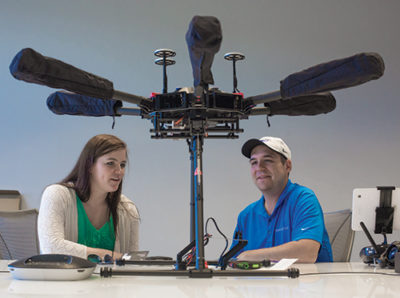
Abby Speicher Carroll and Colin Romberger, chief pilot and operations consultant at DARTdrones, examine a drone from a client.
Her studio apartment in Newton, Massachusetts, which she shared with future husband Mike Carroll, was crammed with paraphernalia, including a prototype for a baby pacifier designed to stayed attached to an infant’s face, equipment and ingredients for making mead and starting a meadery, and a snowboard training device about the size of a table. In all, she was pondering about 20 business ideas. “I was on the hunt,” she says. “I get excited about opportunities, and I can’t resist them.”
Carroll’s intensity isn’t surprising. Growing up in Dunmore, Pennsylvania, a small town near Scranton in the northeastern part of the state, she comes from a family of entrepreneurs. Her grandfather began a food brokerage when he was laid off from the A&P grocery chain, and her grandmother was district sales manager for Avon, supervising some 200 entrepreneurial women selling beauty products. Through the years, Carroll’s father has played various roles in about 30 startups and is now an entrepreneurship professor.
Whether in the classroom or in the many sports she played, Carroll had tenacity as a child, says her father. “She was always persistent,” Speicher says. “She always had that drive.” At 17, Carroll started her first business, a social enterprise that sold purses handmade by women in Ghana. She was inspired to launch the venture after accompanying her father on a trip to the country, and a portion of the profits went to fund children’s education there. For five years, Carroll worked on the business before finally deciding to move on, passing it along to a family friend to run, and the venture is still in operation today.
Carroll’s father also had a hand in the start of DARTdrones. As she debated what type of business to start at Babson, Speicher nudged her toward drones. Growing excited about the aircraft’s commercial potential, Speicher was fascinated when Amazon’s Jeff Bezos went on 60 Minutes in 2013 and demonstrated how a drone could deliver a package. “This is coming on,” Speicher would tell Carroll. “This is going to take over.” In time, she came to agree that drones could be a great business. But shaping and growing that business would be a long, trying process.
Frustration and Inspiration
Carroll began working on DARTdrones in early 2014. Soon enough, doubts followed.
As many entrepreneurs do when launching a business, Carroll first focused on market research. She identified potential competitors and customers, but the work felt unproductive. “Everything was so theoretical,” she says. “I would call people, asking, ‘What are your feelings toward drones?’” The months slipped by. No customers were in sight. By the fall, her classmates were looking ahead to graduation and applying for jobs, but Carroll was tethered to a far-from-solid business concept. “I was nervous,” she says. “DARTdrones was just fluttering around. I can see why people quit at that point.”
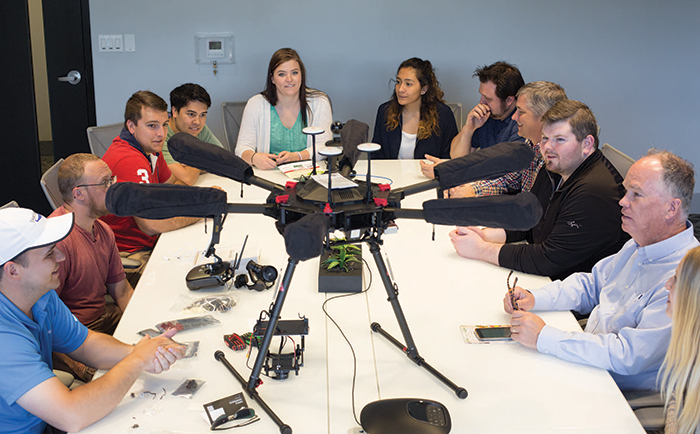
Abby Speicher Carroll and the staff at the DARTdrones office in Jessup, Pennsylvania, gather for a meeting.
Carroll decided to give herself till the winter break to decide whether to continue the business. But then her dad began pressing her with another idea. Why not sell drones, he proposed. The holiday season was coming, and a family friend was willing to invest $50,000. They could order a shipment of drones and then resell them. Drones promised to be a hot holiday gift.
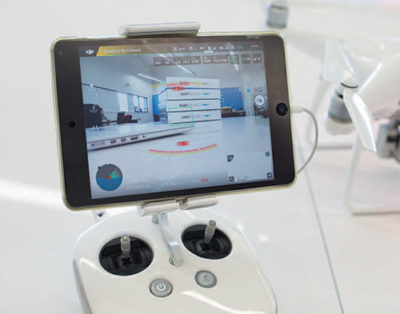
A controller for piloting a drone comes with a video screen that displays the aircraft’s surroundings.
While DARTdrones was envisioned originally as more of an all-encompassing company, one that would sell drones as well as offer instructional support, Carroll had long since decided that a focus on training was the way to go, particularly after her scary flight at the business competition demonstrated the need for such courses. Despite misgivings, she went along with her father’s idea. The hope was that their shipment of drones would come in by Black Friday, which would leave plenty of time to resell them.
That seemingly solid plan went awry, however, as the drones didn’t arrive until after Christmas. “We were stuck with all these drones,” says Carroll. “It was horrible.” Though she was able to sell some in the ensuing weeks, she admits that a bunch of unsold drones, their technology now outdated, are sitting in her parents’ home.
After that fiasco, Carroll was filled with frustration. But she soon had a flash of inspiration that would turn the business around. As someone who follows the industry, she saw that DJI, a leading drone manufacturer, was offering free demos. Carroll had a thought: What if DARTdrones piggybacked on the demos to attract customers? Partnering with DJI, DARTdrones began hosting events throughout the Northeast, presenting DJI’s two-hour demo and then offering a free DARTdrones training session. DARTdrones was able to interact with customers, receive feedback on its course, and spread the word about the company.
Sales took off, and, suddenly, the uncertainty of 2014 gave way to excitement in 2015. In the spring, DARTdrones won Babson’s prestigious BETA competition, and after Carroll’s May graduation, she participated in the College’s Summer Venture Program. Carroll gives much credit to Babson for helping her grow DARTdrones. The College left her with a network of friends to turn to for business advice, and it gave her confidence to know that, whatever issue she faces, there’s probably a case study from her Babson days that covers it. “I couldn’t have made it this far without Babson,” says Carroll, who also took part in the College’s Women Innovating Now Lab. “I’m like the Babson billboard. It was the perfect place for me.”
DARTdrones made a push for expansion through the rest of 2015, thanks in part to a rash comment by Carroll. While talking casually with the owner of DroneLife, an influential industry website, Carroll was told that the site couldn’t cover DARTdrones until it was a national company. “We have plans to go national,” Carroll responded. “By the end of this year, we’ll be national.” At the time, though, DARTdrones actually had no such plans, so Carroll’s mind raced. “I go home. I was like, we have to go national. What’s the plan?”

Abby Speicher Carroll talks with her dad and co-founder, Chris Speicher, an entrepreneurship professor at Marywood University.
A big obstacle to growth was finding enough qualified pilots to teach courses. Eventually, the company was able to recruit 13 pilots of commercial and military aircraft who had an interest in drone technology. The pilots were invited to a multiday train-the-trainer session, though the session’s location concerned Carroll. Because DARTdrones had no money to rent a training space, it had to make do with her parents’ house, with classes held inside and pilots practicing flying on the lawn. Carroll served the pilots mac and cheese and removed all pictures of herself to try to make the house look more professional. In the end, the pilots were trained and had a good time, and the company was on its way to going national.
Since then DARTdrones has continued to recruit instructors and today has about 35. Aviation is a male-dominated world, and as a young woman CEO, Carroll has encountered self-centered pilots who are dismissive of her. She doesn’t put up with them. “I have been deliberate about who joins the company,” Carroll says. “I have denied instructors who don’t seem like they could handle me being in charge.”
Then the Call Came
DARTdrones was on an upswing by the end of 2015, but the unpredictable entrepreneurial journey brought new challenges in 2016, with Carroll facing what she calls a “dark time.” A painful company shake-up, which she declines to talk about, was part of the reason. Beyond that, the long days spent building a venture were finally catching up to her. In a typical week, she worked 80 hours. “It wasn’t sustainable,” she says. “I was really burned out.”
To recharge, she went on a 10-day cruise with her parents and younger brother. The respite worked, and Carroll brought a new mindset back to DARTdrones. She vowed not to work as much, and away from the office, especially on weekends, she made a conscious effort to think less about the business. Not that she completely ditched her full, frenetic life. “She is not one to sit still,” says husband Mike Carroll, whom she married in 2017. For a time she took up painting, and then she and her husband remodeled a house, which meant hours of sanding, painting, and laying floors. Still, a change was noticeable. “The first year or two, every second of the day was DARTdrones,” says her husband. “She now has a different perspective.”
As the dark time subsided, Carroll got a call with major business implications. The previous year, she had applied to be on Shark Tank. Now the TV show called to say her application had been accepted. She would be pitching DARTdrones to the Sharks, the show’s panel of investors.
Carroll’s episode was taped in June 2016. “It was stressful leading up to it,” she says. “You’re worried, ‘What if I totally bomb?’” Thankfully, the taping went well, but afterward, she felt renewed stress. The exposure promised to boost DARTdrones’ business, but the network gave Carroll no indication of when her episode would air. So the company rushed to be ready, redoing its website and adding classes and instructors, while Carroll constantly checked the upcoming TV schedule.
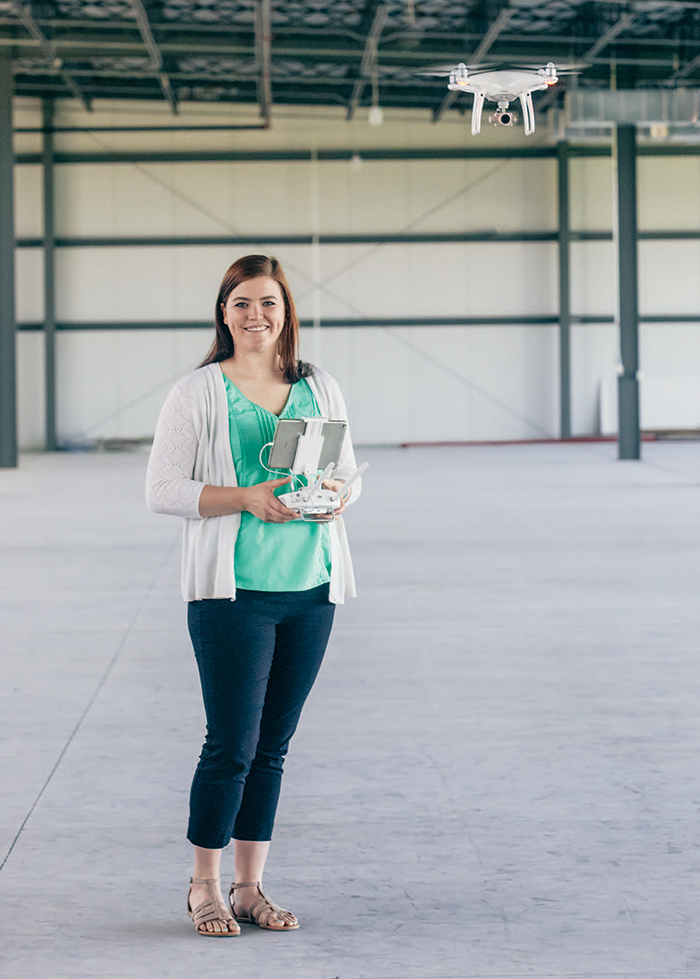
DARTdrones is located within a business center that supports and encourages startups. This large, unoccupied space, which is down the hall from DARTdrones, is slated for future businesses.
Ultimately, the episode didn’t air until February 2017. The night it premiered, Carroll’s parents threw a big party, their house packed with family, friends, and DARTdrones employees. Everyone marveled at Carroll’s poise on the screen, and once the show was over, they all cheered.
After the episode aired, DARTdrones experienced a surge in business. What the company didn’t receive from Shark Tank, however, was a deal. At the taping, Carroll had agreed to give Mark Cuban a 10 percent stake for $300,000, but once the paperwork came to make the deal official, Carroll had second thoughts. She couldn’t see herself giving up any control in the venture she had worked so hard to create. “Having someone in charge of me wasn’t going to work,” she says. “I can’t have a boss. I got into this to be my own boss.” In the end, the paperwork was left unsigned.
Today, thriving DARTdrones offers 40 classes a month across the U.S., and more than 8,000 students have taken its courses. Police and fire departments are big customers, with more than 100 having gone through DARTdrones programs. Although regulations keep some companies cautious about using drones, others are eager to embrace the aircraft’s potential, and so DARTdrones has been tailoring more programs to corporate clients, says Carroll.
Though DARTdrones has an office in Jessup, Pennsylvania, only a short drive from Carroll’s hometown of Dunmore, she and her husband make their home nowadays in Park City, Utah, near the company’s Salt Lake City office. The pair fell in love with the area while attending Salt Lake’s Westminster College, where they met.
Carroll’s husband joined the company in 2016 and serves as director of accounting. Initially, Carroll was nervous about blending her personal and professional lives. “After the first month, I thought it was the best thing,” she says. “It is really nice. We are never apart.” The two bring different strengths to the office, which helps them avoid stepping on each other’s toes. The creative Abby focuses on marketing and strategy, while numbers and logistics are the domain of analytical Mike.
Outside the office, Carroll keeps up her busy lifestyle. She hikes, camps, and snowboards. She also flies to Pennsylvania to visit family and check on the Jessup office. That office sits on a ridge overlooking a valley full of houses, highways, and communities. Standing there, Carroll looks out on a world she has known her entire life.
Despite all the ups and downs, Carroll remains passionate about entrepreneurship. “I hope I am a serial entrepreneur,” she says. “I hope I’ll use this experience for the next business I start.”
]]>But while such a prospect concerns her, she believes that facts, not polemics, will ultimately win the day. “People have to come to these conclusions on their own. I tell my students, ‘I’m giving you the data. You can make your own decisions,’” she says.
From a young age, nature was a passion for Carey. As a child, living outside Rochester, N.Y., she was always drawn to water. “I grew up in the Great Lakes area, and my family sailed. I was skipper of my own sailboat by the time I was 8,” she says.
The future biogeochemist also had an intuitive, almost prescient grasp of her someday career. “When I was 4 or 5, I remember sitting in the back of my mom’s car and seeing pavement being laid somewhere. And I said, ‘Mom, they’re suffocating the earth,’” she recalls. “Now I study soil respiration. I study how soils breathe—how oxygen is taken up by microbes, and how soil microbes release carbon dioxide.”
Carey earned her B.S. in environmental policy and planning at Virginia Tech. She intended to pursue a career in low-impact development, which involves creating systems for runoff that mimic the natural processes of water flow, protecting water quality and aquatic habitats. “And as I studied that,” Carey says, “I started getting more interested in the science and the biogeochemistry behind water quality.” She went straight from college into a master’s degree program in environmental science at Yale’s School of Forestry & Environmental Studies.
She envisioned herself one day running an environmentally focused nonprofit, but at some point, the allure of field work and research took over. She worked for a professor who sent her out to collect samples of river water, and that led Carey to pursue classes in hydrology. Not everyone dreams of standing hip deep in a cold river, filtering water samples, but for Carey, the work was a fit. “I love to push myself physically, and it was fun,” she says, cheerfully recalling a day so cold her samples froze in the syringe.
After Yale, she took a job with the Massachusetts Department of Fish and Game, doing river restoration. “We really responded to constituent concerns,” she says, fielding calls about streams running dry or fish populations disappearing. Carey and her colleagues would investigate the causes behind the concerns. “My knowledge of river hydrology and rivers was solidified there,” she says. “It was a perfect job.”
Carey was on a bus headed to New York, reading a paper about stream flow in a peer-reviewed journal, when she had the thought, “I want to write a paper like this; I want to do this level of science.” Knowing such work would require a Ph.D., she returned to school—this time to Boston University—and earned a doctorate in earth science. Later, she held postdoc positions with the EPA in Rhode Island and at the Marine Biological Laboratory in Woods Hole on Cape Cod before joining the Babson faculty full time in January 2017.
Much of Carey’s research focuses on silicon, an abundant element found on land and in water; she looks at how human activities are altering the amount of silicon that reaches the ocean, which in turn impacts microscopic ocean plants and carbon dioxide levels. In some cases, human activity has decreased levels of silicon, and in others it has increased those levels. Both have significance. “When we’re modeling future climate scenarios, it’s really important to understand the drivers of carbon dioxide, because they’re shifting,” says Carey. It’s serious science that has sent her to Alaska several times to study the mechanisms driving silicon export and the ways in which human activities and climate change alter the flux of silicon to oceans.
Working at Babson might seem a curious choice for someone with Carey’s interests. But she says taking the job was “a no-brainer.” “I love the environment here. My colleagues are so friendly, and while we are dedicated researchers, I like how our focus is also on the students’ Babson experience, rather than solely on our own research endeavors,” she says. “The students are very smart. They ask good questions. And I knew that if I was going to be teaching at a small school, I wanted to teach at a good school.”
In the course she teaches, “Oceanography,” Carey covers the physical, biological, and chemical processes at work in our oceans. While the objective of the course is to impart a basic scientific understanding of these processes, she also addresses such topics as pollution, fisheries management, and renewable energy.
Carey believes that teaching future business leaders might have an even greater impact than teaching future environmentalists who have already, as she puts it, “drunk the Kool-Aid.” “I try to take students out of their business bubble and make them amazed at the natural world. I feel like there’s an avenue for them doing positive things related to the ocean, as entrepreneurs. There are problems the market could maybe fix,” she says. If her students don’t specifically pursue environmental entrepreneurship, she hopes they’ll at least consider their own environmental impact and how natural systems work. “I try to foster their curiosity,” she says.
And she lets the facts speak for themselves. “When I teach climate change, we look at CO2 levels over time,” she says. “We look at a graph showing where we are now and what’s happened over the last 800,000 years. And that graph is just—well, I don’t need to say anything more.”
]]>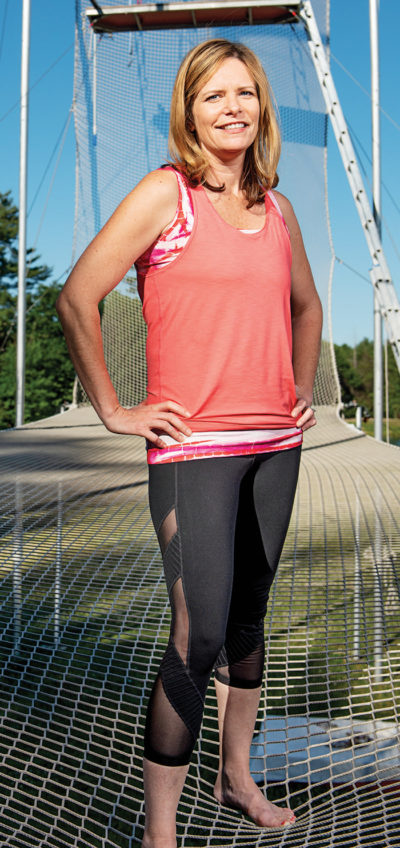
Photo: Webb Chappell
Lauren Belmont, associate director of Academic Technologies
What was your first job? I worked for The Home Depot’s corporate office near Atlanta. They wanted young, creative people to help them design training courses for store employees. I’d put on an apron and work alongside associates who had been there for 20 years and knew every single type of drill bit, fastener, and saw, and I learned extensively about the products myself so that I could design the training.
How did you come North? It was the dot-com boom, and I had a surprising number of job offers from all over. But one was from the Boston area, where my brother was living at the time. He said it’s a great place for young people in technology, and the company paid for my relocation.
When did you come to Babson? In 2005. I was married, and we wanted to start a family—I have three girls—but the company I was working for was small and didn’t have any maternity leave. I talked with HR, and they were nice but not open to any flexibility in my schedule. Babson has been really flexible with me in terms of work-life balance. They made it work in a way that I feel a lot of companies don’t for women.
What are your job responsibilities? I still do some course design and content development, but I’m probably more focused right now on curriculum and production, just because there are so many programs that we’re involved with. I also focus a lot on faculty training, which I love.
What are your hobbies? I’m definitely one of those people who has my Kindle with me all the time. I love historical fiction, particularly anything about World War II or the Civil War. And I’m sort of a thrill-seeker at heart, so you can often find me at Revolution Trapeze in Stow. I started to do flying trapeze a few years ago. It seemed like a good adrenaline rush—and it really is.—Donna Coco
]]>
Photo: Tom Kates
David Zuckerman, MBA’18
After studying biology in college, David Zuckerman, MBA’18, was a researcher for a pediatric oncologist at Dana-Farber Cancer Institute in Boston. Turns out the molecular techniques he was using were sought after by the Centers for Disease Control and Prevention, which hired him to research responses to bioterrorism and set up a lab in Los Angeles. Three years later, in a complete 180, Zuckerman became an investment manager at Merrill Lynch. Family ties, however, eventually pulled him and his wife (and two boys) back East. Now he is in the health-care industry again, working in Boston for Pear Therapeutics, developer of the first FDA-approved app for treating substance abuse.
How did you go from bioterrorism research to investing?
My work at the CDC was really interesting. I got to work with anthrax and smallpox and plague. It was exciting and dangerous. But my next step would have been applying to medical school or getting a Ph.D., and I didn’t want to do either. I always had an interest in the markets and had a connection to an investment group at Merrill Lynch that offered to bring me on if I got my licenses. I stayed with that team until we left California.
Tell me about Pear Therapeutics.
We’re building prescription digital therapeutics, which is a fancy way of saying apps for patients. The first one is for substance use disorder, which is a huge issue all over the country. Patients are prescribed the app along with face-to-face therapy. The app delivers therapy through a mobile device via a series of lessons based on cognitive behavioral therapy. The app includes incentives to do the lessons, and it can report on the patient’s status. Another differential for us is we’ve built a clinician dashboard, so the clinician can see in real time the patient’s progress, cravings, and triggers.
When will it launch?
Mid-2018. We’re building out our pipeline of other products at the same time.
Why get FDA approval?
The FDA asked us the same thing. We have this incredibly strong clinical data and want to make claims that show we can help patients increase abstinence. Now we’re a defined treatment that can be prescribed and not just an app that we hope people download.
Was it hard leaving California?
We had a little apartment seven blocks from the beach in Santa Monica. It was a really great place. We were away from the East Coast for 10 years. I don’t regret a second of it. But it’s nice coming home.—Donna Coco